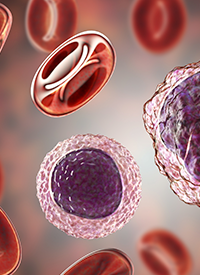News
Article
Anito-Cel Yields 100% Response Rate in R/R Myeloma
All patients with relapsed/refractory multiple myeloma experienced a response when treated with anitocabtagene autoleucel in a phase 1 trial.
Anito-cel in multiple myeloma
Image Credit: © Dr_Microbe -
stock.adobe.com

Treatment with the BCMA-directed CAR T-cell therapy anitocabtagene autoleucel (anito-cel; CART-ddBCMA) led to an overall response rate (ORR) of 100% in patients with relapsed or refractory multiple myeloma, according to data from a phase 1 trial (NCT04155749) presented at the 21st International Myeloma Society Annual Meeting.1
All evaluable patients (n = 38) experienced a response; the complete remission and stringent complete remission (CR/sCR) rate was 76%. At a median follow-up of 26.5 months, investigators reported that median progression-free survival (PFS), duration of response (DOR), and overall survival (OS) end points had not been reached at 2 years.
“It seems likely that the median for the entire difficult-to-treat patient population will be greater than 2 years,” said investigator Binod Dhakal, MD, MS, associate professor of medicine, Medical College of Wisconsin, Division of Hematology, in Milwaukee.
A total of 92% of patients achieved a CR/sCR and very good partial response rate. “Surprising CR/sCR rates were reported across patient subgroups, including patients with extramedullary disease [EMD; 85%; n =13], high-risk cytogenetics [82%; n = 11], high-risk cytogenetics with 1q gain [77%; n = 26], and patients over 65 years of age [85%; n = 20],” Dhakal continued.
At the data cut-off of October 15, 2023, 89% (n = 25/28) of evaluable patients were minimal residual disease–negative at a minimum of 10-5 sensitivity.
In general, patients with EMD have a poor prognosis because of a shorter duration of response and overall survival. “The most impressive finding of this study is that at a follow-up of 33 months, the median PFS was not reached in the EMD group,” Dhakal said.
In patients with EMD (n = 13), the 24-month estimated PFS rate was 57.5% (95% CI, 25.7%-79.9%) and the 18-month estimated PFS rate was 67.1% (95% CI, 34.2%-86.2%). “Follow-up in the non-EMD group was a little shorter at 25 months and is likely to evolve further,” Dhakal continued.
Overall, 6-month, 12-month, 18-month, and 24-month PFS rates were 92.1% (95% CI, 77.5%-97.4%), 75.9% (95% CI, 58.7-86.6%), 63.7% (95% CI, 45.7%-77.2%), and 56.0% (95% CI,37.3%-71.1%), respectively. Dhakal noted that the median was not reached in the overall population, as well as in patient subgroups.
“Some of the highest PFS rates at 24 months were reported in patients with high-risk features such as EMD,” Dhakal said.
Examining the Safety Profile of Anito-Cel
Turning to safety, no cases of delayed neurotoxicity, Guillain-Barré syndrome, cranial nerve palsies, and Parkinsonian-like syndromes were reported for the entire population through the follow-up period. One grade 5 adverse event (AE) of unrelated cardiac arrest attributed to a non-study drug overdose occurred post study.
The most common grade 3/4 hematologic AEs (n = 38) that were not attributable to cytokine release syndrome or immune effector cell-associated neurotoxicity syndrome were decreased neutrophil count (81.6%), anemia (57.9%), and thrombocytopenia (42.1%). Among non-hematologic AEs, the most common were hypertension (7.9%), increased aspartate aminotransferase levels (5.3%), and cellulitis (5.3%).
Anito-cel is under evaluation in the pivotal phase 2 iMMAgine-1 trial (NCT05396885) and the iMMagine-3 trial (NCT06413498), a global phase 3 trial comparing anito-cel with standard of care in patients with relapsed/refractory multiple myeloma after 1 to 3 prior lines of therapy, including an anti-CD38 monoclonal antibody and an immunomodulatory drug (IMiD).
Diving Into Trial Background
The phase 1 first-in-human trial evaluated the CAR T-cell therapy in patients with relapsed/refractory disease who received a prior IMiD, proteasome inhibitor, and CD38-targeted therapy. Eligible patients had received 3 or more lines of therapy or were triple refractory.
Two dose levels were evaluated and 6 patients were enrolled in each dose escalation cohort. Based on the early data, the decision was made to expand dose level 1 (DL 1). A total of 40 patients were enrolled and underwent leukapheresis; 1 patient discontinued due to infection. Thirty-nine patients received lymphodepletion and 1 patient discontinued due to hypoxia/heart failure, resulting in 32 patients who received DL 1 (100 × 106 CAR+ cells) and 6 patients who received DL 2 (300 ×106 CAR+ cells).
The overall median age was 66 years (range, 44-75). For patients who received DL 1, the median age was 66 years (range, 44-76) and for DL 2, the median age was 60 years (range 52-65). The majority of patients were male (61%) and 32% of patients were ECOG performance status 0.
Additionally, 63% of patients had at least 1 high-risk prognostic feature, which was defined as bone marrow plasma cells greater than 60%, ISS stage 3 disease, and EMD; 34% of patients overall had EMD.
Reference
Frigault M, Rosenblatt J, Dhakal B, et al. Phase 1 study of anito-cel (CART-ddBCMA) for the treatment of patients with relapsed and/or refractory multiple myeloma: results from at least 1-year follow-up in all patients. Presented at: 21st International Myeloma Society Annual Meeting; September 25-28, 2024; Rio de Janeiro, Brazil. Abstract OA-30.









